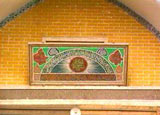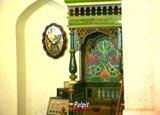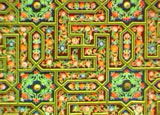 |
|
Idkah |
| CCTV.COM 2003-11-06 09:11:51 |
|
 The Arabs brought Islamism to the East when they launched an expedition in the 10th century. Kashi on the west bank of the Tarim River in Xinjiang, northwest China became a shrine of Islamism. The Arabs brought Islamism to the East when they launched an expedition in the 10th century. Kashi on the west bank of the Tarim River in Xinjiang, northwest China became a shrine of Islamism.
In the 15th century, the ruler in Kashi built Idkah, a magnificent and elegant mosque to pray for the souls of his family.
 “Obviously it has Xinjiang characteristics. Its structure, building materials, pillars and colors reveal Kashi features. It was not copied from other mosques. We can see the major features of Xinjiang and Islamic architectures,” said Wang Xiaodong, deputy general designer of Xinjiang Architecture Designing Institute. “Obviously it has Xinjiang characteristics. Its structure, building materials, pillars and colors reveal Kashi features. It was not copied from other mosques. We can see the major features of Xinjiang and Islamic architectures,” said Wang Xiaodong, deputy general designer of Xinjiang Architecture Designing Institute.
The Idkah Mosque consists of the service hall, the preaching hall and the gateway arch, covering an area of 16,000 square metres. The 12-metre-high gate of the mosque was built of yellow bricks. On both sides of the gateway arch are two 18-metre-high minarets.
 The service hall, the main building, stands on the west side of the mosque. An exquisitely decorated pulpit can be seen at the west wall of the inner hall. The pulpit is the place where the mullah preaches the Koran. The buildings of the Idkah Mosque drew on the architectural style of local people’s houses. The layout of the building is unrestrained. The service hall, the main building, stands on the west side of the mosque. An exquisitely decorated pulpit can be seen at the west wall of the inner hall. The pulpit is the place where the mullah preaches the Koran. The buildings of the Idkah Mosque drew on the architectural style of local people’s houses. The layout of the building is unrestrained.
“The Islamic buildings in Xinjiang are different from the architectural pattern of Han people in our hinterland. In the past the emperor fixed the number of bays, and the height and color of buildings. There are not such strict regulations for Islamic buildings in Xinjiang. Buildings are put up according to their functions, the climate, building materials and the terrain. The height of buildings is determined in accordance with the needs. A triangular room may be built here. A semiarc-shaped room may appear there. Some space can be cleared. So the layout is unrestrained. This is what we seek for our modern buildings today. We proceed from the needs of buildings, not from a certain form. The Islamic buildings in Xinjiang are of great vitality,” said Wang Xiaodong, deputy general designer of Xinjiang Architecture Designing Institute.
 The outer hall of the Idkah Mosque is mainly a wooden structure. The gorgeous ceiling is supported by 140 pillars with carved patterns. The pillars standing on a platform are square-shaped or octagonal. The coffers were painted with the most classical Islamic patterns, especially patterns of flowers, plants and geometric figures. The magnificent patterns of primitive simplicity have made Idkah a mosque with a strong ethnic flavor. The mosque has inherited and developed Islamic architecture. In the meantime, it has created a unique Xinjiang style. The newly decorated Idkah Mosque is ushering in another day of religious service. The outer hall of the Idkah Mosque is mainly a wooden structure. The gorgeous ceiling is supported by 140 pillars with carved patterns. The pillars standing on a platform are square-shaped or octagonal. The coffers were painted with the most classical Islamic patterns, especially patterns of flowers, plants and geometric figures. The magnificent patterns of primitive simplicity have made Idkah a mosque with a strong ethnic flavor. The mosque has inherited and developed Islamic architecture. In the meantime, it has created a unique Xinjiang style. The newly decorated Idkah Mosque is ushering in another day of religious service.
|
|
Editor: Han Ling CCTV.com
|
|
|
|
|
|
 |









